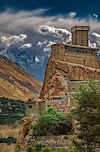Gilgit Baltistan Traveling Guidelines
Gilgit Baltistan Travelling Guidelines; Gilgit-Baltistan
previously known as the Northern Regions is the northernmost political
substance under the managerial control of Pakistan. As per Pakistan's
constitution, Gilgit-Baltistan is an independent area separate from Pakistan
itself, and its occupants have never had any portrayal in Pakistan's
parliament.
Grand K2:
Four mountain ranges meet here the Karakoram, Pamir,
Himalaya, and the Hindu Kush and the region is a "mountain heaven"
for mountain dwellers, travelers, and sightseers. The locale has a portion of
the world's most noteworthy mountains, including five tops north of 8,000 meters,
numerous more than 7,000, and the biggest glacial masses outside the polar
district. For examination, neither Western Europe nor the lower 48 US states
have anything that arrives at 5,000 m, nothing anyplace in Russia or North
America is more than 6250, and the most noteworthy pinnacle of the Andes is
just shy of 7000.
Gilgit-Baltistan is gave with probably the best bounties of
Nature. Sightseers from everywhere the world have an extraordinary fascination
toward this locale in view of its lovely valleys, fields, pinnacles and legacy
destinations. Area of probably the most noteworthy mountains on Earth including
K2. Journeying to Concordia (the intersection of the Baltoro Glacial mass and
the Godwin-Austen Ice sheet) and the incomparable Baltoro Muztagh, a sub-scope
of the Karakoram.
Other destination
• 1 Deosai Public Park
• Pixie Glades is where three popular mountain ranges meet -
the Himalayas, the Karakorams and the Hindukush
• 2 Khunjerab Public Park is a recreation area around the
Khunjerab Pass where the Karakoram Roadway crosses the Pakistan-China line
• 3 Punial valley : Sher Qillah is the fundamental town of
the pleasant Punial valley. One of the greatest towns by region is Hatoon.
• 4 Rama lake - offers a remarkable perspective on the
eastern side of Nanga Parbat, 8126 m high. For the experience adoring traveler,
explorer, fisherman, craftsmanship darling, mountain dweller or polo devotee,
there are not many spots on the planet that could contrast and Gilgit.
• Rock carvings Tracing all the way back to eighth century
Promotion, an immense Buddha figure encompassed by little Buddhisatvas is cut
on a stone, three kilometers from Skardu across Sadpara Nullah on
Skardu-Sadpara Street. Pre-noteworthy men and creature figures are cut on rocks
along Kachura Lake. A few stone carvings and an outline of a religious
community close to Perkuta (Mehdi Abad) Nalah are likewise found.
• Singal This spot in the Punial valley offers ideal trout
fishing potential open doors.
Gilgit, presently the
authoritative focus of this district, was a significant city on the Silk Street
through which Buddhism was spread from India to the remainder of Asia. An
enormous number of Sanskrit Buddhist texts, including the long form of the
Heart Sutra have been uncovered in Gilgit. The Dards and Cizinas additionally
show up in large numbers of the old Pauranic arrangements of people groups,
with the previous tracking down notice in Ptolemy's records of the locale. Two
renowned voyagers, Faxian and Hsuan Tsang, are referred to have navigated
Gilgit according to their records. The old Silk Street course through Gilgit is
presently the Karakoram Parkway (KKH).
Gilgit was controlled for a really long time by the nearby
Trakane Line, which reached a conclusion in around 1810. The region slid into
internecine strife prior to being involved by the Sikhs in 1842. It was
surrendered to Jammu in 1846. Gilgit's occupants drove their new rulers out in
an uprising in 1852. The Khushwakhte Tradition of Yasin and Gulapure drove
individuals of Gilgit to drive out the Dogra rulers. After Yasin was vanquished
by the Katur Tradition of Chitral, the force of the Khushwakhte was squashed.
The standard of Jammu was reestablished in 1860. Gilgit went under English rule
in 1889, when it was brought together with adjoining Hunza and Nagar in the
Gilgit Organization. At the point when English rule reached a conclusion in
1947, the district was momentarily given back to the maharaja of Jammu and
Kashmir. Thusly, it went under Pakistani control. Right up to the present day,
Gilgit-Baltistan remains some portion of the Kashmir debate and India thinks of
it as a Pakistani-involved piece of the Indian association region of Ladakh.
A large part of the number of inhabitants in needs to be
converged into Pakistan as a different territory and goes against coordination
with the remainder of Kashmir, which the Pakistani government has reliably
denied in light of the fact that it would endanger its situation in the Kashmir
debate. In any case, as of November 2020, the Pakistani government is by all
accounts taking actions towards changing over it into an undeniable territory.
How much this will play out is not entirely clear, yet it is broadly accepted
that such a move could additionally demolish Indo-Pakistani relations and lead
to additional pressures in the entire of Kashmir, as numerous Kashmiri
patriots/favorable to Freedom allies believe the locale to be a basic piece of Kashmir.
Gilgit-Baltistan covers an area of 72,971 km² (28,174
mi²) and is incredibly uneven.
Talks/Languages:
Urdu is the public language of Pakistan spoken all through
Pakistan, including Gilgit-Baltistan, as the most widely used language. The
neighborhood dialects are Shina, Balti, Khowar, Wakhi and Burushaski. As
somewhere else in Pakistan, English is decently broadly spoken among the
informed classes and those engaged with the vacationer business. Different
dialects incorporates Purgi, Domaaki, Pashto, Kyrgyz, Luneci, Brokskat,
Ladakhi, Uyghur, Shughni, Ishkashimi, Sarikoli, Uzbek, Turkmen, Munji, and
Changthang.






0 Comments